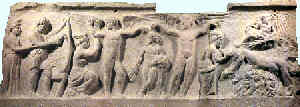

The Village![]()
The houses are built amphitheatrically on the surrounding hills, looking over the picturesque harbor. The steep almost vertically cut rocks dominate the landscape, a mark of prehistorical geological changes, and the view to the Libyan sea is boundless.
There are many newly built houses, plenty of hotels, pensions etc, but there are also many old ones reminding the calmness and good taste of the past.
The visitor can walk through the narrow, paved streets and admire the blooming yards, buy souvenirs from the market, drink a "raki" at the "kafenio" (traditional cafe) talk with the friendly and hospitable local people and learn about the customs, the legends, the myths and the history of the place.
The port is, in the summer time, a point where the interest of visitors is concentrated, because of the facilities it provides.
At the area of the harbour are taking place some cultural events or festivals (nautical week etc), organized by the cultural association and the municipality.
The protecting saint of Agia Galini are the Saints Four Martyrs. They were named Georgios, Agelis, Manouil and Nikolaos and they were from the village of Melabes. They were slaughtered by the Turkish commander of Rethimno because they were Christians. The inhabitants of Agia Galini to honor this sacrifice, built a temple in the first quarter of the 20th century and dedicated it to the saints. The pillars in the entrance of the temple made from dark granite, in accordance with the locals come from the ancient temple dedicated to Artemis or Athina.
The History![]()
There are two possible derivations of the name Agia Galini (in Greek Galini means calm, peace).
The first one is of Byzantine origin. According to that, a ship carrying the Byzantine empress Eudokia, due to a great storm, was forced to anchor to the harbor of Agia Galini. The empress went ashore and prayed to the Holy Mother to calm the sea and promised to built a church in this place. The miracle happened, the sea calmed and the empress built the church that is saved until today in the village cemetery.
The second possible derivation is from the name of a church dedicated to Galinios (peaceful) Jesus that there used to be in Agia Galini.
In the Agia Galini bay, there was discovered a Roman ship wreck dated from the 3rd AD century, from which the archaeologists pulled up a treasure containing copper items, coins, statues, lamps etc. that today are exhibited in the Archaeological Museum of Rethimno.
In the mouth of the river that is located east of Agia Galini, named "Plati", is the place where according to the legend Ulysses stranded, on the way to his home Ithaki from Troy.
In the location where Agia Galini is built, there was the ancient city of Soulia, which was one of the hundred cities of Crete that Homer describes. It was a place of worship of the goddess Athina or Artemis and there was a magnificent temple of the goddess built there. The history of Soulia continues up to the 7th AD century, when it is destroyed by Saracenes pirates. From 640 to 1884 darkness covers the area of Agia Galini. After 1884 begins the reconstruction of Agia Galini, from inhabitants of the nearby villages. Its inhabitants at the beginning were mainly occupied with farming and fishing. Trade begun to flourish, and with the construction of the port of Agia Galini, the village becomes an important trade and economical center of the area.


